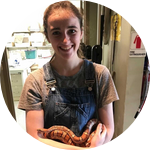About This Project
Second-generation anticoagulant rodenticides were recently banned in California to protect wildlife health. Unfortunately, this ban didn’t restrict the use of other rodenticides such as bromethalin, a neurotoxin that has been detected in mountain lions in the greater Los Angeles region. We will test exposure in local coyotes (a food source for mountain lions), comparing levels before and after the ban to see if bromethalin exposure changed after heightened restrictions on other rodenticides.
Ask the Scientists
Join The DiscussionWhat is the context of this research?
Rodenticides remain an important part of rodent control, but unfortunately they have the potential to cause disease or death in non-target wildlife species. In California (CA), attention to non-target exposure in charismatic animals such as mountain lions, bobcats, and endangered spotted owls helped lead to the Ecosystems Protection Act, which imposed a ban on second-generation anticoagulant rodenticides in January 2021. However, an Annual Report by the CA Department of Fish and Wildlife revealed that over half of animals tested in 2021 were still exposed to rodenticides. Legislative efforts are underway to add additional anticoagulants to the list of restricted compounds, but this leaves out other rodenticides such as bromethalin, which has also been reported as toxic in local wildlife.
What is the significance of this project?
Rodenticide management is an ongoing conservation issue, and research is critical to understand the impacts of rodenticide restrictions on non-target wildlife. We will assess exposure to the non-anticoagulant rodenticide bromethalin around Los Angeles, using coyotes as an indicator species since they are common throughout the region. Exposure prevalence will directly inform local wildlife agencies about the risk of this highly neurotoxic rodenticide in the region, where mountain lion exposure has been detected despite bromethalin being thought of as low risk for secondary poisoning through prey. Funding bromethalin testing is also important to help evaluate if rodenticide policy beyond anticoagulant restrictions are needed to protect the health of California wildlife.
What are the goals of the project?
Bromethalin testing will provide a more comprehensive picture of the impact of rodenticides in wildlife. Funds will be used to test bromethalin exposure in 40 coyotes, collected before and after the 2021 anticoagulant rodenticide ban. Bromethalin usage may have increased in recent years due to heightened restrictions on other rodenticides, and by testing 20 samples from both time periods we will get a first look at possible exposure differences. We currently have 20 pre-ban samples collected before 2021, and 12 samples collected after 2021. Opportunistic sample collection will continue through the fall in order to obtain 20 post-ban samples. All samples will be sent to an external laboratory for analysis, and as soon as we have results they will be shared with local wildlife agencies.
Budget
Funds will pay for bromethalin testing in 40 animals. We will test twenty coyotes sampled before and after the anticoagulant rodenticide ban, allowing us to investigate if bromethalin exposure increased when other rodenticides were restricted. Results will complement and extend a larger project researching the health, diet and pathogens of Los Angeles wildlife, which uses existing funds to study exposure to anticoagulant rodenticides before and after their recent ban, the proportion of human related diet sources, and the relationship these both have to coyote health. This additional bromethalin testing will inform rodenticide policy makers, while providing insights into how this compound may alter coyote ecology and health. For example, if we find that animals with higher levels of bromethalin have higher pathogen loads or rely more on human food sources, that would suggest that this toxicant may be altering their health, behavior and ecology.
Endorsed by
 Project Timeline
Project Timeline
We have 20 samples already collected that can be used to assess bromethalin levels in coyotes before the 2021 anticoagulant rodenticide ban. Those samples will be analyzed this summer upon receipt of the funding. We will aim to finish collection for samples collected after the ban in fall 2023, and those samples will be sent out for analysis by the end of the year. Once results are received, we will summarize the data and share all results with local wildlife health and regulatory agencies.
Jun 26, 2023
Project Launched
Jul 31, 2023
Analyze initial 20 samples (pre-ban)
Nov 01, 2023
Finish collection of post-ban samples
Dec 01, 2023
Analyze final 20 samples (post-ban)
Jan 31, 2024
Analyze and distribute results to California wildlife agencies
Meet the Team
Team Bio
This project is a collaborative research effort between the UCLA La Kretz Center for California Conservation Science, the Lloyd-Smith Lab, the National Park Service, and the Urban Nature Research Center at the Natural History Museum of Los Angeles County.
Sarah Helman
As a veterinarian and wildlife lover, I am incredibly excited to be researching wildlife health and ecology in the greater Los Angeles region. After obtaining my undergraduate degree from Boston University in 2006 (B.A. Biology, specialization in ecology & conservation biology), I went on to veterinary school at the University of Edinburgh, Scotland (class of 2010). After graduation I worked as a small animal veterinarian in Queensland, Australia, where I volunteered with a local sea turtle rehabilitation organization and increased my interests in coastal wildlife health and conservation ecology. I decided to pursue a PhD in research focusing on wildlife health, and found the perfect fit for this in the James Lloyd-Smith zoonotic disease lab at UCLA. Since then I have utilized my background in ecology and veterinary medicine to research wildlife health and disease ecology along the California coast. After finishing my PhD in 2022, I started a 2-year postdoctoral research fellowship at the UCLA La Kretz Center for California Conservation Science, focused on how diet and rodenticide exposure influence local coyote health and ecology. These surveys are a critical step in identifying the prevalence of diseases in different mammal populations and understanding factors that impact diseases in wildlife, and results will directly inform wildlife, veterinary and public health agencies. I'm extremely grateful to be working on such an exciting project with an amazing team of collaborators and fantastic undergraduate students (the future doctors and scientists of the world) as we continue to learn more about the health and ecology of local wildlife populations.
Thanks for your interest!!
Caitlin Cox
Caitlin is a soon-to-be graduating senior majoring in mathematics at UCLA, and a long-standing wildlife lover and rehabilitator. Since joining the Lloyd-Smith Lab in 2018, she has made huge contributions to wildlife surveillance projects, data analyses and coding challenges. She is really interested in how computer science and applied mathematics can be used in conservation and OneHealth contexts. Her interests in exploring bromethalin exposure and toxicity in wildlife stem from seeing animals suffering from bromethalin seizures in the wildlife rehabilitation center she worked at, and she sparked a conversation with the National Park Service about exposure in local mountain lions which made us want to further explore this toxin locally.
Additional Information
NOTE: Our team collaborates with local wildlife agencies to sample coyotes non-invasively on an opportunistic basis. All samples have been and will be obtained from animals that died or were euthanized or found dead due to other causes (e.g., traffic injuries or fatalities). When a dead coyote is reported to us, we send out a member of our research team to collect and return it to UCLA for necropsy and sample collection. This provides opportunities for undergraduate researchers, many of which are future doctors and veterinarians, who have the opportunity to gain experience in wildlife research and medicine.
Cover Photo Source: Mountain lion P-65 and her three kittens in the Santa Monica Mountains National Recreation Area (photo credit: National Park Service; also seen in this Los Angeles KTLA news article). Tragically, this animal later died of severe mange, with a toxicology report revealing exposure to multiple rodenticides, including Bromethalin.
Project Backers
- 61Backers
- 110%Funded
- $5,506Total Donations
- $65.67Average Donation



